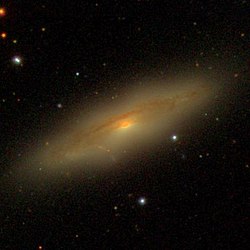NGC 4586
Jump to navigation
Jump to search
| NGC 4586 | |
|---|---|
 SDSS image of NGC 4586. | |
| Observation data (J2000 epoch) | |
| Constellation | Virgo |
| Right ascension | 12h 38m 28.4s[1] |
| Declination | 04° 19′ 09″[1] |
| Redshift | 0.002648[1] |
| Helio radial velocity | 794 km/s[1] |
| Distance | 51 Mly (15.5 Mpc)[1] |
| Group or cluster | Virgo II Groups |
| Apparent magnitude (V) | 12.7[1] |
| Characteristics | |
| Type | SA(s)a[1] |
| Size | ~60,900 ly (18.68 kpc) (estimated)[1] |
| Apparent size (V) | 2.90 x 0.99[1] |
| Other designations | |
| CGCG 42-187, IRAS 12359+0435, MCG 1-32-122, PGC 42241, UGC 7804, VCC 1760[1] | |
NGC 4586 is a spiral galaxy located about 50 million light-years away[2] in the constellation Virgo.[3] The galaxy was discovered by astronomer William Herschel on February 2, 1786.[4] Although listed in the Virgo Cluster Catalog,[5] NGC 4586 is considered to be a member of the Virgo II Groups which form a southern extension of the Virgo cluster.[6][7] NGC 4586 is currently in the process of infalling into the Virgo Cluster and is predicted to enter the cluster in about 500 million years.[8]
Boxy/Peanut bulge
NGC 4586 has a boxy or peanut-shaped bulge. The bulge has been interpreted to be a bar viewed edge-on.[9][10]
See also
References
- ^ a b c d e f g h i j "NASA/IPAC Extragalactic Database". Results for NGC 4586. Retrieved 2018-03-02.
- ^ "Your NED Search Results". ned.ipac.caltech.edu. Retrieved 2018-03-03.
- ^ "Revised NGC Data for NGC 4586". spider.seds.org. Retrieved 2018-03-03.
- ^ "New General Catalog Objects: NGC 4550 - 4599". cseligman.com. Retrieved 2018-03-03.
- ^ Binggeli, B.; Sandage, A.; Tammann, G. A. (1985-09-01). "Studies of the Virgo Cluster. II - A catalog of 2096 galaxies in the Virgo Cluster area". The Astronomical Journal. 90: 1681–1759. Bibcode:1985AJ.....90.1681B. doi:10.1086/113874. ISSN 0004-6256.
- ^ Tully, R. B. (June 1982). "The Local Supercluster". The Astrophysical Journal. 257: 389–422. Bibcode:1982ApJ...257..389T. doi:10.1086/159999. ISSN 0004-637X.
- ^ "The Virgo II Groups". www.atlasoftheuniverse.com. Retrieved 2018-03-03.
- ^ Tully, R. B.; Shaya, E. J. (June 1984). "Infall of galaxies into the Virgo cluster and some cosmological constraints". The Astrophysical Journal. 281: 31–55. Bibcode:1984ApJ...281...31T. doi:10.1086/162073. ISSN 0004-637X.
- ^ Corsini, E. M.; Pizzella, A.; Coccato, L.; Bertola, F. (2003-09-01). "Minor-axis velocity gradients in spirals and the case of inner polar disks". Astronomy & Astrophysics. 408 (3): 873–885. arXiv:astro-ph/0306382. Bibcode:2003A&A...408..873C. doi:10.1051/0004-6361:20030951. ISSN 0004-6361. S2CID 17961897.
- ^ Bender, Ralf (2003-01-23). The Mass of Galaxies at Low and High Redshift: Proceedings of the European Southern Observatory and Universitäts-Sternwarte München Workshop Held in Venice, Italy, 24-26 October 2001. Springer Science & Business Media. ISBN 9783540002055.
External links
Wikimedia Commons has media related to NGC 4586.
- NGC 4586 on WikiSky: DSS2, SDSS, GALEX, IRAS, Hydrogen α, X-Ray, Astrophoto, Sky Map, Articles and images